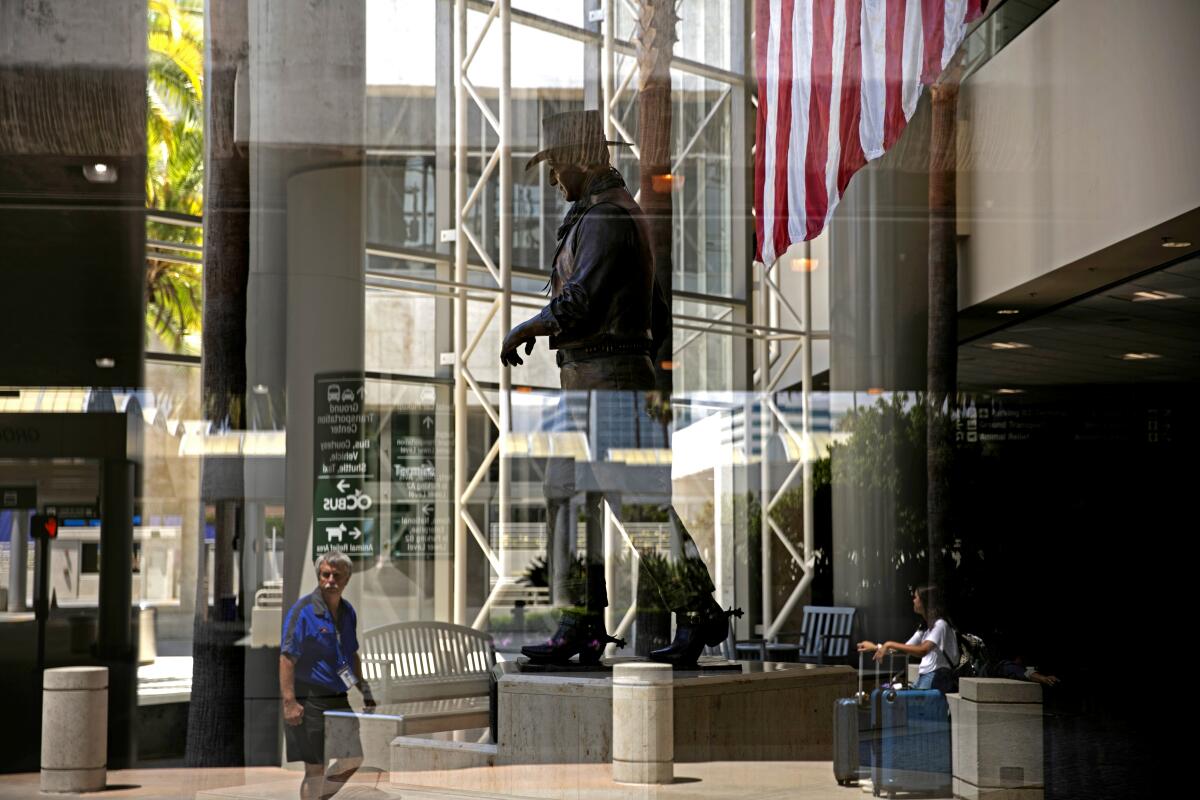Editorial: Renaming John Wayne Airport can help Orange County confront its racist past

- Share via
John Wayne was no hero, but he played them. His laconic acting style lent itself to his frequent roles as brave cowboys or soldiers. The Newport Beach homeowner was easily Orange County’s most famous person of the mid-20th century. He fit in well there as a symbol of rugged individualism and conservatism; he was a onetime member of the right-wing John Birch Society. The county named its airport for Wayne after he died in 1979, a small-town move even at the time.
Democratic leaders in the historically Republican county — which now has an entirely Democratic congressional delegation — want to revert to the old name: Orange County Airport. Though the current Black Lives Matter movement has given that idea a push, this isn’t the first time it’s been raised. Wayne’s 1971 interview with Playboy magazine, for those who were doing more than looking at the pictures, laid out disgraceful bigotry toward Black people and Native Americans.
“I believe in white supremacy,” he said. And, “I don’t believe in giving authority and positions of leadership and judgment to irresponsible people.” No problem with white people stealing this country from indigenous people; white people needed more land.
For all that, Wayne doesn’t fit in easily with the statue-tumblings and calls for renaming buildings and institutions in recent weeks. He did not wage war against the United States to defend slavery, like Jefferson Davis or Robert E. Lee. Nor is he one of the former presidents — like Washington, Jefferson and Wilson — whose legacies are being reexamined anew as America grapples with its original sins of genocide and slavery.

In general, we favor retaining honors for those who, on balance, are known for their lasting, positive impact. Pure goodness is extremely rare; everyone has an ugly side.
Woodrow Wilson is a complicated case. Ask Americans what they know about Wilson, whose name is being stripped from Princeton University’s international affairs school, and most will mumble something about the League of Nations and World War I. Fewer realize that he also was an raging racist, extreme even for his time, who purged Black federal employees from their jobs and segregated government workplaces.
The less important debate about these people is who deserves a building named for them; the bigger one is why so few of us knew about Wilson’s racism, Jefferson’s hypocrisy, and the ugly warts of our many revered figures?
The time has come for us to stop revering and instead reckon with the complex interweaving of heroism and evil in history. That reckoning should begin in public school. Even at a young age, students should learn about Jefferson’s slaveholding as well as his statesmanship, about Wilson’s racism as well as his internationalism. They should learn the names of George Washington’s slaves — and recognize that our nation’s founder was far from perfect.
Lessons will be truer and more engaging if they teach that all leaders have been imperfect.
Though ethnic studies courses are essential, they alone won’t solve this, especially if schools isolate the topic into a single semester and say, “Great! Took care of that thorny problem.” The threads of bigotry, violence, inequality, racism, misogyny and human rights violations run through history, both world and American.
In this larger context, John Wayne is small potatoes. His influence on history is a blip, if that. The objections to the airport’s name are based on a single interview and not on any harm done to others. Wayne’s house on Newport Bay overlooked a far more problematically named place — Balboa Island, named for the explorer/conquistador Vasco Núñez de Balboa, who famously caught a view of the Pacific Ocean and less famously tortured and savagely killed indigenous people in his pursuit of gold.
The naming of John Wayne Airport was a provincial decision by a county that had not yet matured. The name is outmoded and means little to the under-65 crowd. There’s no great reason to keep it, especially given Wayne’s ugly comments, but the Democratic Party in Orange County also hasn’t mounted a convincing argument for changing it.
The Black Lives Matter movement has also given the county a moment to reflect on a more central matter: its own history of racism. A century ago, prominent leaders in Orange County civic life joined the Ku Klux Klan. Its members held four of five City Council seats in Anaheim. Other members patrolled the streets in robes and masks, interrogated people and held a rally that drew 20,000 people.
During the mid-20th century, white flight from Los Angeles played a major role in building Orange County’s population. There were the infamous NIN calls in Newport Beach, the abbreviation standing for a deplorable phrase meaning that a Black person’s presence within the boundaries of the city was suspect and reason for police to pull them over. Housing discrimination was a common and ongoing problem.
Though times have changed and Orange County is far more racially and ethnically diverse, that diversity still does not include Black people, who make up only 2% of the population compared with 9% in Los Angeles County.
Change the airport’s name or not, it’s more important to recognize and express remorse for decades of direct and systemic racism in Orange County.
More to Read
A cure for the common opinion
Get thought-provoking perspectives with our weekly newsletter.
You may occasionally receive promotional content from the Los Angeles Times.










